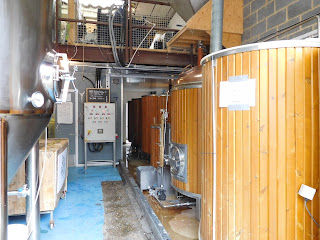
Earlier last week,
CAMRA held the official launch of its
flagship publication; the
2017 Good Beer Guide. Most beer lovers and, indeed,
many pub goers will be familiar with the
GBG which is now in its
44th
edition. The Guide lists
4,500 pubs which serve the best pints of
“real ale”
which can be found, up and down the country. It also gives details of every
brewery in the country.
Like any self-respecting publisher,
CAMRA wanted to give
this latest edition the best launch possible, so it put out
four different press releases, each highlighting a different aspect of the guide, in order to
create the maximum amount of publicity. These releases were:
> Fishy business: Good Beer Guide reports moves to axe
isinglass.
> CAMRA's Good Beer Guide warns global brewers threaten choice.
> New ‘safe drinking’ limits are rocky road to prohibition.
> Good Beer Guide celebrates London
as Beer Boom
City.
Two of these releases were slightly controversial, and
whilst such topics might be considered good publicity, unfortunately for the
campaign, the press picked up on the first one and ran with it. They ran with it
so much, that the use of isinglass finings as a means of clarifying beer, ended
up overshadowing the Good Beer Guide itself, and its celebration of all that is
best within British pubs and British brewing.
The press, being the press, also got much of the story
wrong; no surprises there, so it’s worth taking a much more detailed look at a
practice which has gone on largely unnoticed, and without controversy for a
couple of hundred years, and probably much longer.

When beer is ready to be racked into casks, it typically
contains around one million yeast cells per millilitre. This amount of yeast
creates an undesirable haze in the beer, so it has to be separated out. If the
beer is to be sent out as “brewery conditioned”, where the secondary
fermentation takes place in the brewery, in conditioning tanks, there are
several means to remove the yeast, prior to packaging. The most common are
centrifuging and filtration; both of which result in a nice clear glass of
beer.
For cask conditioned beer (“real ale”) though, it is necessary for the yeast to
remain in the cask in order to allow a secondary fermentation in the beer. If
the cask is left long enough, the yeast will eventually settle naturally,
leaving the beer bright and clear, but as most pubs cannot afford this luxury
this is where the use of isinglass finings comes into its own.
 |
| Isinglass finings - ready for use |
To achieve adequate cask conditioning, but also allow the
landlord to serve a clear pint, brewers add a processing aid known as finings to
the cask; the most common of which is isinglass finings. Isinglass is a type of
collagen which is derived primarily from fish swim bladders. At one time these
swim bladders were obtained from fish such as sturgeon, but these days the most
common sources are catfish, drumfish and threadfins caught in tropical and
subtropical waters.
To prepare isinglass as a fining agent, the swim bladders
are removed from the fish and dried naturally. If dried too quickly much of the
clarification potential can be lost, so this is by nature a slow process. Once
dried the bladders are cleaned, sterilised and ‘cut’ in acid. The cutting
process results in an emulsion-like white liquid known as isinglass, which is
then ready to add to beer.
 |
| Sturgeon |
The means by which clarification of the beer takes place is
that the isinglass passes through it rather like a fishing net. The yeast cells
become enmeshed in the net by means of an electro-static interaction between
the positively charged sites on the collagen molecule and the negatively
charged surface of the yeast cell. This creates a bond between yeast and
isinglass. This newly created particle is quite large in size and so sediments
out of the beer far quicker than the yeast would naturally. The pub landlord
now has a nicely clarified cask of ale ready for serving.
As mentioned earlier, this practice has been carried out for
many years, and some historians even credit the Romans for its discovery as a
means of clarifying wine. Fast forward two thousand years to the 21st
Century, and drinkers who are either vegetarian or vegan, are clamouring for
the use of isinglass to be restricted, or indeed discontinued. A spokesman for
the Vegetarian Society said, "The use of isinglass in drinks production is
a major frustration for vegetarian beer lovers as there are very few obvious ways
to identify whether or not it has been used."
 |
| Dried swim bladders |
This frustration comes about because isinglass is not
classified as an ingredient and is therefore exempt from Food Labelling
Regulations. Despite pressure for Isinglass to be included under the 2003 EC
Labelling Directive, the brewing industry successfully argued that it was a
processing aid, not an ingredient that would be consumed. Isinglass finings are
a tried and tested method of clarifying beer, and with a long history of use
with no recorded incidents of an allergic reaction, there was a good case for
isinglass to be exempt from the directive.
Now CAMRA has entered the debate with a call in the
2017
Good Beer Guide for breweries to examine alternatives to isinglass, as a means
of clarifying beer. The
BBC ran with
this story, but at least they were more accurate than some newspapers who falsely
reported that
CAMRA had called for an outright ban on isinglass.
CAMRA hurriedly issued a denial, but the damage appears to
have been done, with some breweries receiving calls from disgruntled consumers,
asking them to discontinue using isinglass in their beers. The
BBC
contacted a couple of breweries who have done just that, and stopped the use of
isinglass, but unfortunately this is where emotion and abject subjectivity
starts taking over from reason and scientific fact, with people talking about
dead fish and even
“fish guts” in beer.
Use of the latter term would imply isinglass is produced
from the fish’s digestive system, which of course it is not. The swim bladder,
which allows the fish to control its depth without having to expend energy by
swimming, is located in the upper portion of the fish, well away from the
stomach and other digestive organs.
It is therefore disingenuous, and also highly emotive to
label isinglass as “fish guts”, but whilst I can perhaps understand vegetarians
and vegans using such terms, brewers should know better. Of course companies,
who don’t use isinglass, may view it as advantageous to describe fined beers in
this way, and whilst I personally have no problem with un-fined beers, I think
they are being more than a little dishonest with both themselves and the
drinking public.
This does lead on to the equally controversial problems
associated with hazy beers; un-fined or otherwise. Again, I am quite happy to
drink a slightly hazy beer, but unfortunately a substantial number of drinkers
are not. The misconception that hazy beer will give you a dose of the “trots”
the following day still persists; in fact a friend of mine, who could best be
described as “old school”, insists this myth is true and will return any beer
with the slightest of haze, even if it tastes perfectly fine. He is not alone,
and this false belief, which seems to have been kicking around since before I started
drinking, over 40 years ago, persists and brewers who produce un-fined beer
will to struggle to dispel it.

Some have taken to issuing notices, which appear at the
point of sale (on the pump clip or bottle), advising drinkers that the beer is
naturally hazy. These developments are to be applauded, as educating drinkers
is the obvious way forward, but what of plant-based alternatives to isinglass,
such as
Irish Moss or synthetic materials like
silica gels?
From what I have read, vegetable derived finings perform
well initially, but having worked once are incapable of clearing the beer for a
second or indeed third time. This is an important consideration, as a cask may
be moved several times during its journey from brewery to pub cellar, and each
time the carefully settled sediment is disturbed. This is where isinglass comes
into its own, as it is capable of working several times over.
To sum up, isinglass is not derived form “fish guts”, and
neither is it an ingredient in beer. It is best described as a
“processing aid”, as once the finings have done their work, by attracting and
combining with the yeast cells suspended in the beer, it forms a layer of
sediment called “trub”, which sits at
the bottom of the cask. Finings are thus not present in the clear bright beer
which ends up in the consumer’s glass, so let’s cut out the emotion and
hysteria over this, and carry on enjoying good, honest, traditional British Cask Ale.
 Just over a year ago I was fortunate to visit the De Halve Maan Brewery (the Half Moon Brewery), in the historic city of Bruges.
I was there with a group of beer bloggers and writers, on the last day of the
European Beer Bloggers post-conference tour. We had spent the night in Bruges,
after a packed day touring round East Flanders, and the
following morning had been treated to a walking tour of the city.
Just over a year ago I was fortunate to visit the De Halve Maan Brewery (the Half Moon Brewery), in the historic city of Bruges.
I was there with a group of beer bloggers and writers, on the last day of the
European Beer Bloggers post-conference tour. We had spent the night in Bruges,
after a packed day touring round East Flanders, and the
following morning had been treated to a walking tour of the city.
 Whilst we were at the brewery, we were informed of the
company’s innovative and ambitious plan to run a pipeline from the brewery, to
the bottling plant. This would enable them to remove, at a stroke, the 40 tonne
tankers which run daily, back and forth between the two facilities. If you have
ever been to Bruges you will at once realise that the city’s narrow streets,
many of which date back to the Middle Ages, were not designed with modern
transportation in mind, so De Halve Maan were really keen to turn this pipe
dream (if you’ll pardon the pun), into reality; not just for their own
convenience, but because they desired to give something back to the city.
Whilst we were at the brewery, we were informed of the
company’s innovative and ambitious plan to run a pipeline from the brewery, to
the bottling plant. This would enable them to remove, at a stroke, the 40 tonne
tankers which run daily, back and forth between the two facilities. If you have
ever been to Bruges you will at once realise that the city’s narrow streets,
many of which date back to the Middle Ages, were not designed with modern
transportation in mind, so De Halve Maan were really keen to turn this pipe
dream (if you’ll pardon the pun), into reality; not just for their own
convenience, but because they desired to give something back to the city.






































